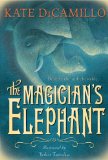Summary | Excerpt | Reading Guide | Reviews | Beyond the Book | Read-Alikes | Genres & Themes | Author Bio

Critics' Opinion:
Readers' Opinion:
First Published:
Sep 2009, 208 pages
Paperback:
Mar 2011, 208 pages
 Book Reviewed by:
Book Reviewed by:
Tamara Ellis Smith
Buy This Book
This article relates to The Magician's Elephant
The magician in The Magician's Elephant makes an elephant appear. But what about an elephant that disappears?

In 1918, Houdini made an elephant vanish from the middle of the Hippodrome Theatre in New York before over 5000 pairs of eyes. Jennie was an 8 foot tall, 6,000 pound Asian elephant and when Houdini brought her onto the stage she would raise her trunk as though she were saying hello to the audience, and then she would walk into a box on wheels - and disappear.
Who taught Houdini how to do this magic trick? And how did Houdini do it?
First the who. In the early part of the 1900's, a man named Charles Morritt (1860-1936), sold and taught Houdini the basic principles of this illusion. A few years ago, Morritt's great-nephew, Norman Allen, researched his family ancestry and uncovered the story of this not-so-famous illusionist and hypnotist from Yorkshire, England.
Morritt was interested in magic as a teenager. He taught himself card tricks and some of the rudimentary elements of hypnotism. At that time he was captivated by two American magicians called The Davenport Brothers whose claim-to-fame was an illusion-trick in which they would tie themselves up inside a locked wooden cabinet filled with musical instruments. The instruments would be heard playing while the magicians were trapped and tied in the cabinet. Morritt was motivated by these magicians to build his own cabinet and by the time he was 18 he gave his own public magic show where he performed mind-reading tricks, rabbit tricks and a trick using the cabinet he had made - only his trick did not involve being tied up, but instead was a disappearing act. It was the beginning of his "vanishing illusion." He honed a handful of these illusions and performed them for a few years, but while he truly was a mastermind of these amazing illusions, he was not all that good of a performer.
Houdini was. In the early part of the 1900's, Houdini was already a well known escapologist, but he wanted to do more. He wanted to do magic. Specifically he wanted to create illusions. And he needed to find someone to teach him how to do just that. Morritt was the magician for the job. He needed the money and so he sold Houdini a few of his illusion-tricks.
Houdini learned these illusions and began to perform them in his own shows. One of them was called the Disappearing Donkey - the predecessor to the Vanishing Elephant. The story goes that one night Morritt came to see Houdini's show. Afterward, he came backstage and challenged Houdini to create an even bigger and better illusion. "Make an elephant disappear," he said. Houdini was skeptical at first. He didn't believe it could be done. How could large enough equipment be made? And how could an elephant be brought onto the stage in the first place?
This is where the what comes in. No one is exactly sure how this illusion was created, but most experts agree that it was probably achieved by using a mirror. Remember Jennie, the 8 foot tall, 6000 pound Asian elephant? She was brought on stage and led into a huge box on wheels. Her trainer would hide her behind a huge mirror that ran diagonally from one corner of the box - the one nearest to the audience - to the middle of the doors at the back of the box. So when the doors were opened again, it appeared that the box was empty. The audience thought they were looking at an empty box. But - they were really only looking at one half of the box, and its reflection.
Although it took a while for Houdini to perfect this illusion - his first attempts were clumsy and rather transparent - he eventually did, and became famous for vanishing an elephant.
Filed under People, Eras & Events
![]() This "beyond the book article" relates to The Magician's Elephant. It originally ran in September 2009 and has been updated for the
March 2011 paperback edition.
Go to magazine.
This "beyond the book article" relates to The Magician's Elephant. It originally ran in September 2009 and has been updated for the
March 2011 paperback edition.
Go to magazine.





The Flower Sisters
by Michelle Collins Anderson
From the new Fannie Flagg of the Ozarks, a richly-woven story of family, forgiveness, and reinvention.

The House on Biscayne Bay
by Chanel Cleeton
As death stalks a gothic mansion in Miami, the lives of two women intertwine as the past and present collide.

The Funeral Cryer by Wenyan Lu
Debut novelist Wenyan Lu brings us this witty yet profound story about one woman's midlife reawakening in contemporary rural China.
Your guide toexceptional books
BookBrowse seeks out and recommends the best in contemporary fiction and nonfiction—books that not only engage and entertain but also deepen our understanding of ourselves and the world around us.